Unit 9 Have you ever been to a museum? 单元教学设计(共6课时)2023-2024学年人教版八年级英语下册
文档属性
| 名称 | Unit 9 Have you ever been to a museum? 单元教学设计(共6课时)2023-2024学年人教版八年级英语下册 |
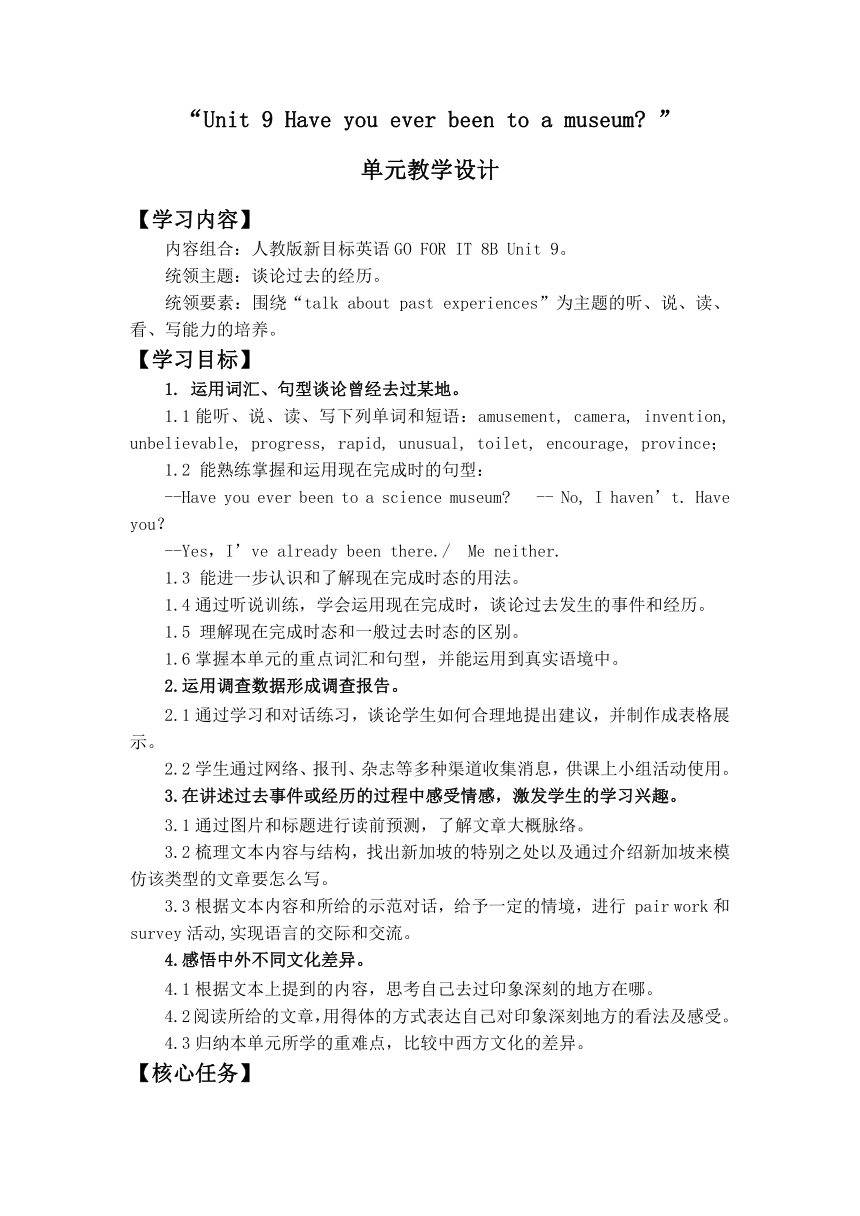
|
|
| 格式 | docx | ||
| 文件大小 | 37.4KB | ||
| 资源类型 | 教案 | ||
| 版本资源 | 人教新目标(Go for it)版 | ||
| 科目 | 英语 | ||
| 更新时间 | 2024-01-29 15:35:44 | ||
图片预览

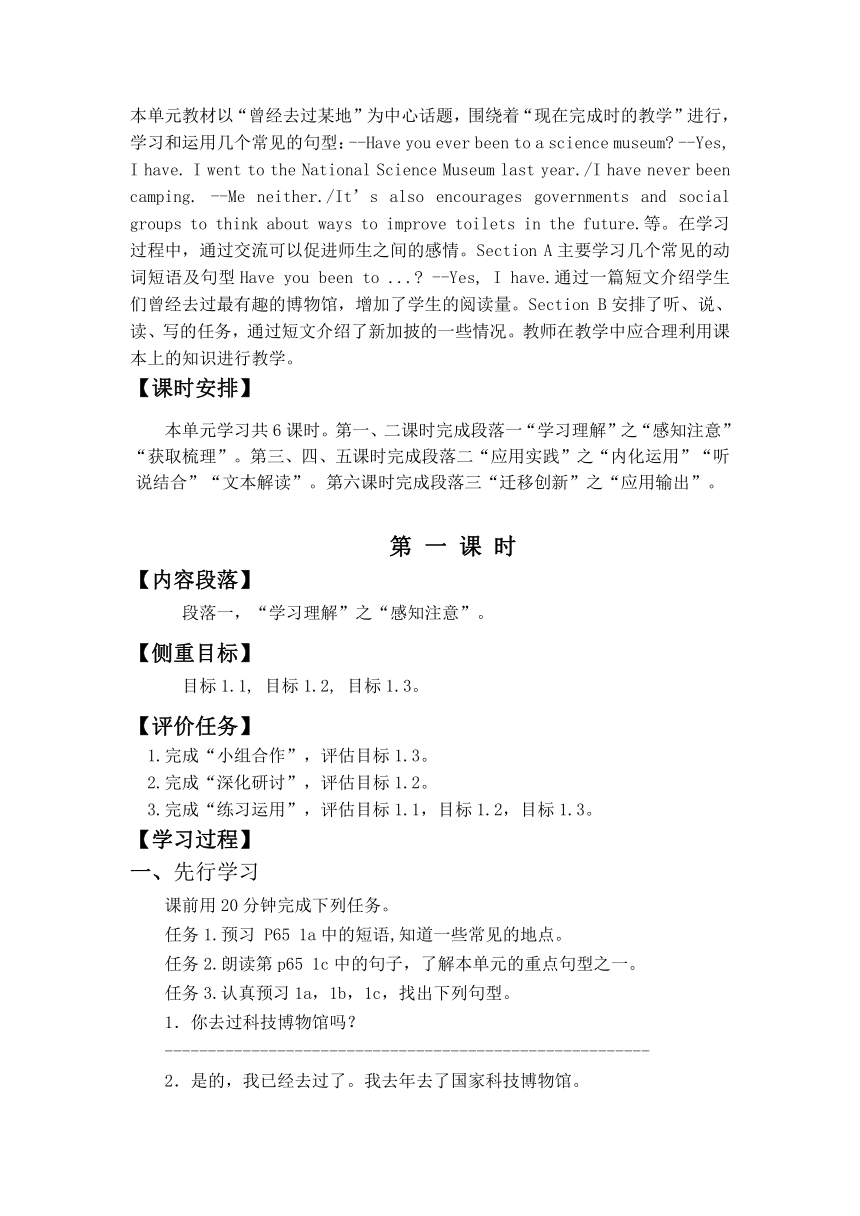
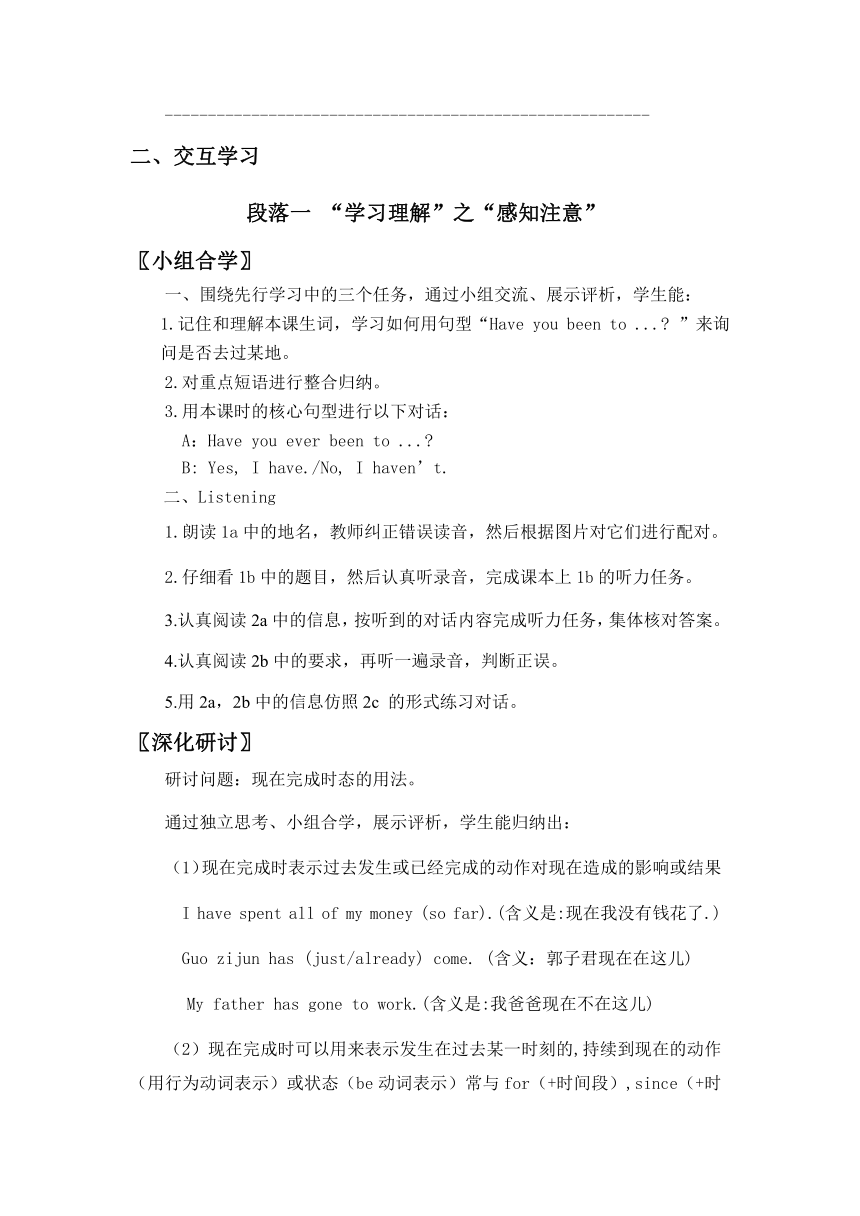
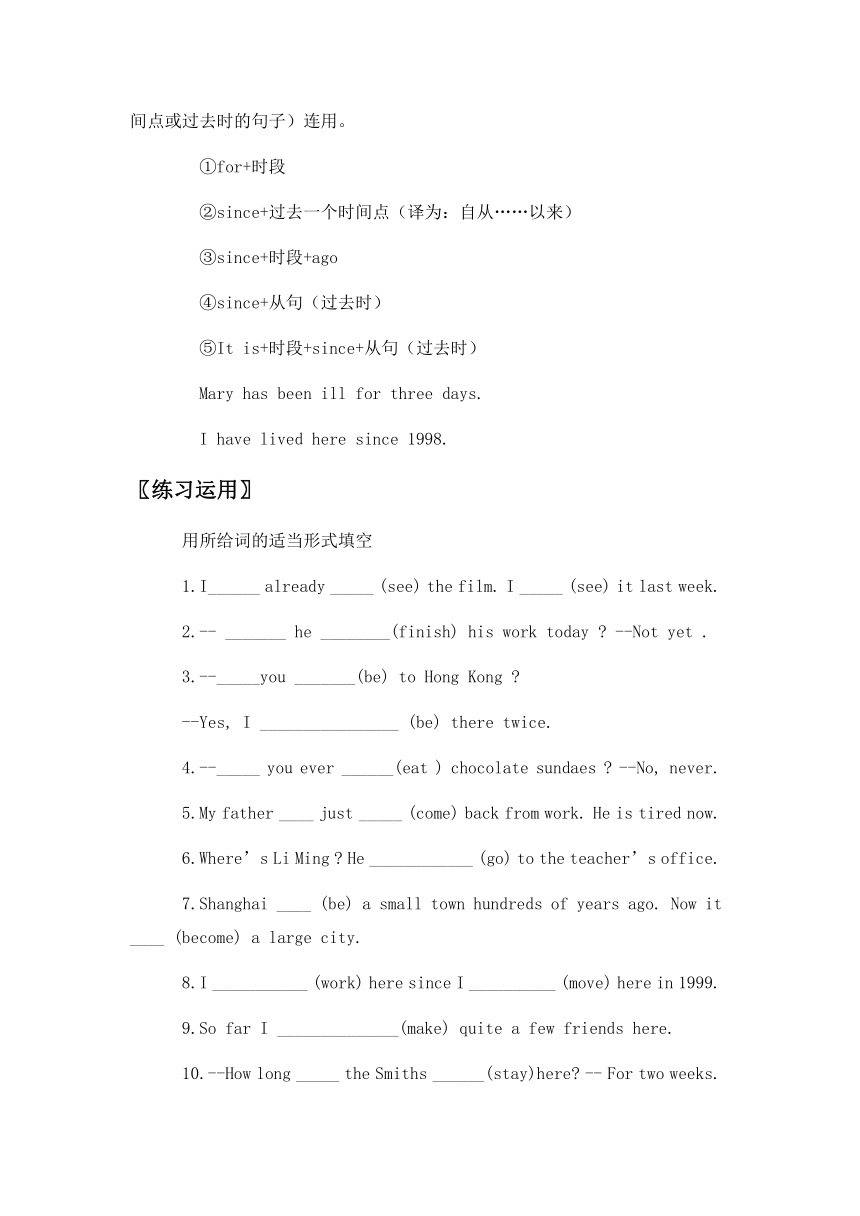
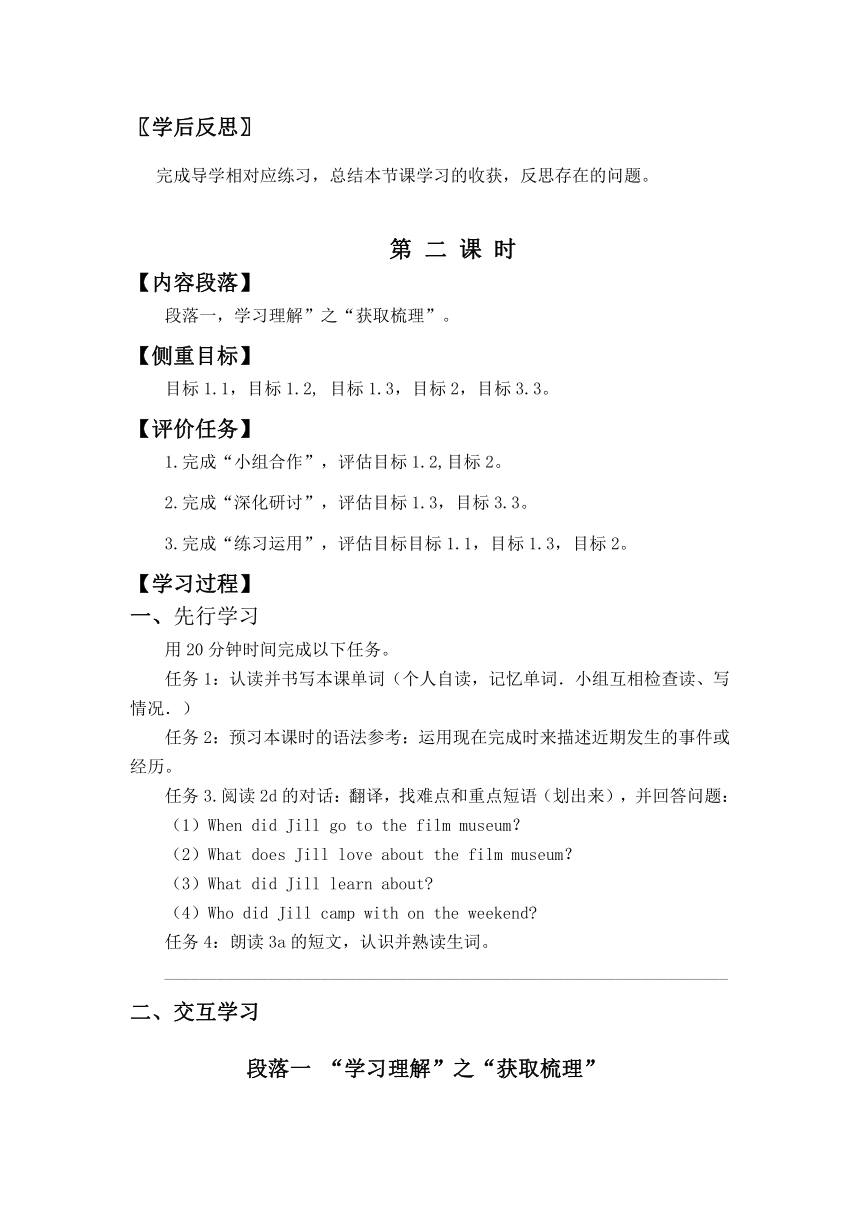
文档简介
“Unit 9 Have you ever been to a museum ”
单元教学设计
【学习内容】
内容组合:人教版新目标英语GO FOR IT 8B Unit 9。
统领主题:谈论过去的经历。
统领要素:围绕“talk about past experiences”为主题的听、说、读、看、写能力的培养。
【学习目标】
运用词汇、句型谈论曾经去过某地。
1.1能听、说、读、写下列单词和短语:amusement, camera, invention, unbelievable, progress, rapid, unusual, toilet, encourage, province;
1.2 能熟练掌握和运用现在完成时的句型:
--Have you ever been to a science museum -- No, I haven’t. Have you?
--Yes,I’ve already been there./ Me neither.
1.3 能进一步认识和了解现在完成时态的用法。
1.4通过听说训练,学会运用现在完成时,谈论过去发生的事件和经历。
1.5 理解现在完成时态和一般过去时态的区别。
1.6掌握本单元的重点词汇和句型,并能运用到真实语境中。
2.运用调查数据形成调查报告。
2.1通过学习和对话练习,谈论学生如何合理地提出建议,并制作成表格展示。
2.2学生通过网络、报刊、杂志等多种渠道收集消息,供课上小组活动使用。
3.在讲述过去事件或经历的过程中感受情感,激发学生的学习兴趣。
3.1通过图片和标题进行读前预测,了解文章大概脉络。
3.2梳理文本内容与结构,找出新加坡的特别之处以及通过介绍新加坡来模仿该类型的文章要怎么写。
3.3根据文本内容和所给的示范对话,给予一定的情境,进行 pair work和 survey活动,实现语言的交际和交流。
4.感悟中外不同文化差异。
4.1根据文本上提到的内容,思考自己去过印象深刻的地方在哪。
4.2阅读所给的文章,用得体的方式表达自己对印象深刻地方的看法及感受。
4.3归纳本单元所学的重难点,比较中西方文化的差异。
【核心任务】
本单元教材以“曾经去过某地”为中心话题,围绕着“现在完成时的教学”进行,学习和运用几个常见的句型:--Have you ever been to a science museum --Yes, I have. I went to the National Science Museum last year./I have never been camping. --Me neither./It’s also encourages governments and social groups to think about ways to improve toilets in the future.等。在学习过程中,通过交流可以促进师生之间的感情。Section A主要学习几个常见的动词短语及句型Have you been to ... --Yes, I have.通过一篇短文介绍学生们曾经去过最有趣的博物馆,增加了学生的阅读量。Section B安排了听、说、读、写的任务,通过短文介绍了新加披的一些情况。教师在教学中应合理利用课本上的知识进行教学。
【课时安排】
本单元学习共6课时。第一、二课时完成段落一“学习理解”之“感知注意”“获取梳理”。第三、四、五课时完成段落二“应用实践”之“内化运用”“听说结合”“文本解读”。第六课时完成段落三“迁移创新”之“应用输出”。
第 一 课 时
【内容段落】
段落一,“学习理解”之“感知注意”。
【侧重目标】
目标1.1, 目标1.2, 目标1.3。
【评价任务】
1.完成“小组合作”,评估目标1.3。
2.完成“深化研讨”,评估目标1.2。
3.完成“练习运用”,评估目标1.1,目标1.2,目标1.3。
【学习过程】
一、先行学习
课前用20分钟完成下列任务。
任务1.预习 P65 1a中的短语,知道一些常见的地点。
任务2.朗读第p65 1c中的句子,了解本单元的重点句型之一。
任务3.认真预习1a,1b,1c,找出下列句型。
你去过科技博物馆吗?
--------------------------------------------------------
2.是的,我已经去过了。我去年去了国家科技博物馆。
--------------------------------------------------------
二、交互学习
段落一 “学习理解”之“感知注意”
〖小组合学〗
一、围绕先行学习中的三个任务,通过小组交流、展示评析,学生能:
1.记住和理解本课生词,学习如何用句型“Have you been to ... ”来询问是否去过某地。
2.对重点短语进行整合归纳。
3.用本课时的核心句型进行以下对话:
A:Have you ever been to ...
B: Yes, I have./No, I haven’t.
二、Listening
1.朗读1a中的地名,教师纠正错误读音,然后根据图片对它们进行配对。
2.仔细看1b中的题目,然后认真听录音,完成课本上1b的听力任务。
3.认真阅读2a中的信息,按听到的对话内容完成听力任务,集体核对答案。
4.认真阅读2b中的要求,再听一遍录音,判断正误。
5.用2a,2b中的信息仿照2c 的形式练习对话。
〖深化研讨〗
研讨问题:现在完成时态的用法。
通过独立思考、小组合学,展示评析,学生能归纳出:
(1)现在完成时表示过去发生或已经完成的动作对现在造成的影响或结果
I have spent all of my money (so far).(含义是:现在我没有钱花了.)
Guo zijun has (just/already) come. (含义:郭子君现在在这儿)
My father has gone to work.(含义是:我爸爸现在不在这儿)
(2)现在完成时可以用来表示发生在过去某一时刻的,持续到现在的动作(用行为动词表示)或状态(be动词表示)常与for(+时间段),since(+时间点或过去时的句子)连用。
①for+时段
②since+过去一个时间点(译为:自从……以来)
③since+时段+ago
④since+从句(过去时)
⑤It is+时段+since+从句(过去时)
Mary has been ill for three days.
I have lived here since 1998.
〖练习运用〗
用所给词的适当形式填空
1.I______ already _____ (see) the film. I _____ (see) it last week.
2.-- _______ he ________(finish) his work today --Not yet .
3.--_____you _______(be) to Hong Kong
--Yes, I ________________ (be) there twice.
4.--_____ you ever ______(eat ) chocolate sundaes --No, never.
5.My father ____ just _____ (come) back from work. He is tired now.
6.Where’s Li Ming He ____________ (go) to the teacher’s office.
7.Shanghai ____ (be) a small town hundreds of years ago. Now it ____ (become) a large city.
8.I ___________ (work) here since I __________ (move) here in 1999.
9.So far I ______________(make) quite a few friends here.
10.--How long _____ the Smiths ______(stay)here -- For two weeks.
〖学后反思〗
完成导学相对应练习,总结本节课学习的收获,反思存在的问题。
第 二 课 时
【内容段落】
段落一,学习理解”之“获取梳理”。
【侧重目标】
目标1.1,目标1.2, 目标1.3,目标2,目标3.3。
【评价任务】
1.完成“小组合作”,评估目标1.2,目标2。
2.完成“深化研讨”,评估目标1.3,目标3.3。
3.完成“练习运用”,评估目标目标1.1,目标1.3,目标2。
【学习过程】
一、先行学习
用20分钟时间完成以下任务。
任务1:认读并书写本课单词(个人自读,记忆单词.小组互相检查读、写
情况.)
任务2:预习本课时的语法参考:运用现在完成时来描述近期发生的事件或经历。
任务3.阅读2d的对话:翻译,找难点和重点短语(划出来),并回答问题:
(1)When did Jill go to the film museum?
(2)What does Jill love about the film museum?
(3)What did Jill learn about
(4)Who did Jill camp with on the weekend
任务4:朗读3a的短文,认识并熟读生词。
_________________________________________________________________
二、交互学习
段落一 “学习理解”之“获取梳理”
〖小组合学〗
围绕先行学习中的三个任务,通过小组研讨、展示评析,学生能:
1.根据调查结果,绘制表格。
2.根据对话创编一个真实的语境,进行role-play。
3.Reading.
Pre-reading
Show three pictures and let the students predict information about the passage in 3a.
While-reading
Fast reading
Ask the Ss to read the magazine article and answer the question.
Which three museums do the Ss talk about
2.Give some sentences, let Ss read them again, and choose T or F.
Careful reading
Read the article carefully and answer the questions.
What does Ken say about the American Computer Museum
What can we learn at the International Museum of Toilets
Why is the Hangzhou National Tea Museum a nice place to enjoy tea
2.Let Ss read the passage quickly, match the words with their meanings and learn some new words.
Post-reading
Summary.
Tell Ss to retell the passage briefly.
〖深化研讨〗
研讨问题:has gone (to),has been (to), has been (in) 的区别
通过独立思考、小组合学,学生能归纳其语法特征:
Have/Has gone(to) :去了(现在不在说话现场)
Where is your father?He has gone to Shanghai.
Have/Has been (to) :去过(已不在去过的地方)
My father has been to Shanghai.
Have/has been in:呆了多久(还在所呆的地方)
My father has been in Shanghai for two months. /since two months ago.
注意:当to后面的地点是here,there等地点副词时,to/in要省略。
〖练习运用〗
单项。
1. Li Hong has ________ the army for 2 years.
A. joined B. be in C. been in D. joined in
2. We have been friends since ______.
A. children B. five years C. five years ago D. five years before
3. Mike ___________ the story for a month.
A. has bought B. has had C. had had D. has borrowed
4. You ______ that question three times.
A. already asked B. have already asked
C. already have asked D. asked already
5. Those foreign friends left Guangzhou __________.
A. since last week B. a week ago C. for a week D. since a week ago
6. I _____ at this school for two years.
A. am studying B. study C. studied D. have studied
7. They _________ in the city since last summer.
A. Live B. didn’t live C. have lived D. live
〖学后反思〗
1.梳理和绘制学习本单元A部分的“talk about past experiences”话题思维导图。
2.完成导学作业,总结本节课的学习收获,反思学习中存在的问题。
第 三 课 时
【内容段落】
段落二,“应用实践”之“内化运用”。
【侧重目标】
目标1.2,目标1.3,目标2.2,目标3.2,目标3.3。
【评价任务】
1.完成“小组合作”,评估目标1.2,目标1.3,目标 3.2。
2.完成“深度研学”,评估目标3.3。
3.完成“练习运用”,评估目标2.2。
【学习过程】
先行学习
课前用20分钟时间独立完成以下任务。
任务1:熟读并识记本单元的重点词汇。
任务2. 阅读Grammar Focus,并找出规律。
______________________________________
任务3:继续学习本单元得重点句型结构。
二、交互学习
段落二 “应用实践”之“内化运用”
〖小组合学〗
围绕先行学习中的三个任务,通过小组合学、展示评析,学生能:
Read the sentences aloud in Grammar Focus.
2.Fill in the blanks according to Grammar Focus.
3.Practice: complete 4a.
4.complete 4b.
5.complete 4c.
6.summary.
〖深化研讨〗
研讨问题:现在完成时的标志。
通过独立思考、小组合学,学生能归纳其语法特征:
1. 现在完成时的含义之一是过去完成的动作对现在仍有影响,用以下四大标志词可以表达这种含义:
* 以already, just和yet为标志
He has already got her help. 他已得到她的帮助。
He has just seen the film. 他刚刚看过这场电影。
He hasn't come back yet. 他还没有回来。
* 以ever和never为标志
This is the best film I have ever seen.
He has never been to Beijing. 他从没有到过北京。
* 以动作发生的次数为标志
He says he has been to the USA three times.
* 以so far(到目前为止)为标+before
He has got to Beijing so far. 到目前为止他已到了北京。
She has passed the examso far. 到目前为止她已经通过了考试。
2.过去已经开始的动作一直延续到现在, 甚至有可能继续延续下去,我们可以从动作“延续”的特性和“时间”点段的区分入手,进一步学习现在完成时。
*①for+时段 ②since+过去一个时间点(过去 从句)为标志
注意: 1)现在完成时不能单独与过去的时间状语连用, 如yesterday,last week, three years ago 等; 2)不能与when连用 2.现在完成时往往同表示不确定的过去时间状语连用
〖练习运用〗
用所给词的适当形式填空
11. --- I ___________ (see) the film “Chicken Run”.
--- Where and when ________ you _______ (see) it
--- Last week.
12. Mary _____ already _______ (have) her supper.
13. I ____________ (not want) to see the film. I ___________ (see) it with my parents. We _________ (see) it last Sunday.
14.--______ Uncle Wang ______ (mend) the TV yet --Yes, he______.
--When _____ he _____ it -- Yesterday.
15. ______ you _______ (read) today’s newspaper yet
16. They _____already_____(do) their homework. But they don’t
know what_____ (do) next.
17. ---____ you _____ (see) the film last night
---No, I ___________ (see) it for several times.
18. She ____________ (be) ill for three days.
19. My father ___________ ( buy) a book for me yesterday. He____ already _________(pay) fifty yuan for it.
20. She____________ (not read) this book before.
〖学后反思〗
完成导学作业,总结本节课的学习收获,反思学习中存在的问题。
第 四 课 时
【内容段落】
段落二,“应用实践”之“听说结合”。
【侧重目标】
目标1,目标2。
【评价任务】
1.完成“小组合作”,评估目标1.6, 目标2.2。
2.完成“练习运用”,评估目标2.1,目标2.2。
【学习过程】
一、先行学习
课前用20分钟时间独立完成以下任务:
任务1:参照预习单上的图片,认知单词及短语。
任务2:思考:你有喜欢去的名胜古迹吗?对它了解有多少?
二、交互学习
段落二 “应用实践”之“深入文本”
〖小组合学〗
围绕先行学习中的四个任务,通过小组合学、展示评析,学生能:
1.教师领读词组,强调个别单词的读音,学生快速记忆词组并且两人一组互相提问。
2.认真观察1a的问题,根据情况进行对话练习。
3.听录音,选出听到的问题。
4.再听录音,完成表格。
5.询问家人或者朋友,他们去过哪些风景名胜区?两人一组完成对话。
〖练习运用〗
单项选择。
Mrs. Wang has lived in Haikou _________ 1992.
A. since B. from C. after D. in
9. Mr. Black _________ China since the summer of 1998.
A. has been to B. has been in C. has come to D. came to
10. His father _______ for years.
A. has died B. has been dead C. died D. dies
11. Mary ________ to see the films because she __________ it twice.
A. won’t go, saw B. won’t go, will see
C. won’t go, has seen D. didn’t go, sees
12.-- Would you like some more food --Thank you. I _____ enough.
A. will have B. have had C. have D. had
〖学后反思〗
完成导学作业,总结本节课的学习收获,反思学习中存在的问题。
第 五 课 时
【内容段落】
段落二,“应用实践”之“文本解读”。
【侧重目标】
目标3.1,目标4。
【评价任务】
1.完成“小组合学”评估目标3.1,目标4。
2.完成“练习运用”评估目标4。
【学习过程】
一、先行学习
课前用20分钟时间独立完成以下任务:
任务1:个人自读,记忆本课单词,读后小组互相检查单词阅读情况;
任务2:阅读2b短文,以小组为单位,共同找出本课中的重点内容,然后在组内交流探讨。
任务3:翻译。
一方面,超过四分之三的人口是中国人。
2.你将不费吹灰之力找到米饭、面条或者水饺。
3.无论你喜欢印度餐、西餐还是日式料理,你都能在新加披找到。
4.天黑的时候去动物园可能看起来有些奇怪。
任务4:Read and draw a mind-map about the context of the passage.
________________________________________________________________
交互学习
段落二 “应用实践”之“文本解读”
〖小组合学〗
围绕先行学习1-4任务,通过小组合学,展示评析,学生能:
1.掌握本单元的重点词汇。
2.能正确运用本单元的句型和表达句式,并能应用到实际情境中去。
Pre-reading
Show the pictures about Singapore and talk about it.
Which is the National Flag of Singapore
What’s the official language in Singapore
Where is the Singapore
While-reading
Fast reading
Let Ss read and match each paragraph with the main ideas.
Careful reading
Read Para.1 carefully and answer the three questions.
Where is the Singapore
How do many Chinese tourists like Singapore
What language do people speak in Singapore
read Para.2 and choose T or F.
read Para.3 and fill in the blanks.
read Para.4 and answer the questions.
How is the weather in Singapore And why
Can we go to Singapore in winter
Work in 2d,2e.
Post-reading
ask Ss to retell the article.
Let the Ss make a travel strategy of your city for your friends in Singapore.
〖练习运用〗
单项选择。
13. ______ you ______ England Yes, it _____ a beautiful country.
A. Will, gone to, was B.Have, been to, is
C. Had, been to, is D.Have, gone to, is
14. ----_______ you _______ to Beijing
----No, I ______.I ______ there early next month.
A. Have, been, haven’t, am going B. Had, been, hadn’t, am going
C. Have, gone, haven’t, was going D. Did,go, didn’t, was going
15. ---You sister ______ to London to study English. Is that true
---Yes , she ___ there for two months.
A. has been, has been B. will go, has gone
C. gone, will be D. has gone, has been
16. He has a computer of his own. He ____ it two days ago
A. bought B. bought C. bought D. has bought
17. —Where is Li Lei —He ___ Shanghai.
A. has gone to B. has been to C. went to D. goes to
18. He _______ his homework and is now listening to music.
A.. finishes B. has finished C. finish D. is finishing
19. David _______ Shanghai for more than three months.
A. came to B. has been to C. has been in D. has come to
20. --- Is your father a Party member
--- Yes, he ____ the party three years ago. He _____ a Party member for three years.
A. joined; has been B. has joined; has been
C. was joined; is D. joined; was
〖学后反思〗
通过自我评价,量化思考,学生能找出存在问题,调整学习策略。
第 六 课 时
【内容段落】
段落三,“迁移创新”之“应用输出”。
【侧重目标】
目标3.1,目标4。
【评价任务】
1.完成“小组合学”评估目标3.1,目标4。
2.完成“练习运用”评估目标4。
【学习过程】
一、先行学习
课前用20分钟时间独立完成以下任务:
任务1:复习本单元重点词汇或短语。
任务2:运用相应的句式,谈论过去去过的景点,并能组织语言讲经历。
交互学习
段落三 “迁移创新”之“应用输出”
〖小组合学〗
围绕先行学习两个任务,通过小组合学,展示评析,学生能:
灵活应用重点词汇。
能向别人讲述音乐对自己的改变。
Pre-writing
Work on 3a: Let Ss make a list of facts about their hometown or a place they have been to.
While-writing
Ask Ss to write a passage. Use the information in 3a & 3b.
Post-writing
1.Evaluation.
2.Summarize their advantages and disadvantages.
〖练习运用〗
Self check 1, 2,3.
三、后续学习
1.进行第九单元的检测。
单元教学设计
【学习内容】
内容组合:人教版新目标英语GO FOR IT 8B Unit 9。
统领主题:谈论过去的经历。
统领要素:围绕“talk about past experiences”为主题的听、说、读、看、写能力的培养。
【学习目标】
运用词汇、句型谈论曾经去过某地。
1.1能听、说、读、写下列单词和短语:amusement, camera, invention, unbelievable, progress, rapid, unusual, toilet, encourage, province;
1.2 能熟练掌握和运用现在完成时的句型:
--Have you ever been to a science museum -- No, I haven’t. Have you?
--Yes,I’ve already been there./ Me neither.
1.3 能进一步认识和了解现在完成时态的用法。
1.4通过听说训练,学会运用现在完成时,谈论过去发生的事件和经历。
1.5 理解现在完成时态和一般过去时态的区别。
1.6掌握本单元的重点词汇和句型,并能运用到真实语境中。
2.运用调查数据形成调查报告。
2.1通过学习和对话练习,谈论学生如何合理地提出建议,并制作成表格展示。
2.2学生通过网络、报刊、杂志等多种渠道收集消息,供课上小组活动使用。
3.在讲述过去事件或经历的过程中感受情感,激发学生的学习兴趣。
3.1通过图片和标题进行读前预测,了解文章大概脉络。
3.2梳理文本内容与结构,找出新加坡的特别之处以及通过介绍新加坡来模仿该类型的文章要怎么写。
3.3根据文本内容和所给的示范对话,给予一定的情境,进行 pair work和 survey活动,实现语言的交际和交流。
4.感悟中外不同文化差异。
4.1根据文本上提到的内容,思考自己去过印象深刻的地方在哪。
4.2阅读所给的文章,用得体的方式表达自己对印象深刻地方的看法及感受。
4.3归纳本单元所学的重难点,比较中西方文化的差异。
【核心任务】
本单元教材以“曾经去过某地”为中心话题,围绕着“现在完成时的教学”进行,学习和运用几个常见的句型:--Have you ever been to a science museum --Yes, I have. I went to the National Science Museum last year./I have never been camping. --Me neither./It’s also encourages governments and social groups to think about ways to improve toilets in the future.等。在学习过程中,通过交流可以促进师生之间的感情。Section A主要学习几个常见的动词短语及句型Have you been to ... --Yes, I have.通过一篇短文介绍学生们曾经去过最有趣的博物馆,增加了学生的阅读量。Section B安排了听、说、读、写的任务,通过短文介绍了新加披的一些情况。教师在教学中应合理利用课本上的知识进行教学。
【课时安排】
本单元学习共6课时。第一、二课时完成段落一“学习理解”之“感知注意”“获取梳理”。第三、四、五课时完成段落二“应用实践”之“内化运用”“听说结合”“文本解读”。第六课时完成段落三“迁移创新”之“应用输出”。
第 一 课 时
【内容段落】
段落一,“学习理解”之“感知注意”。
【侧重目标】
目标1.1, 目标1.2, 目标1.3。
【评价任务】
1.完成“小组合作”,评估目标1.3。
2.完成“深化研讨”,评估目标1.2。
3.完成“练习运用”,评估目标1.1,目标1.2,目标1.3。
【学习过程】
一、先行学习
课前用20分钟完成下列任务。
任务1.预习 P65 1a中的短语,知道一些常见的地点。
任务2.朗读第p65 1c中的句子,了解本单元的重点句型之一。
任务3.认真预习1a,1b,1c,找出下列句型。
你去过科技博物馆吗?
--------------------------------------------------------
2.是的,我已经去过了。我去年去了国家科技博物馆。
--------------------------------------------------------
二、交互学习
段落一 “学习理解”之“感知注意”
〖小组合学〗
一、围绕先行学习中的三个任务,通过小组交流、展示评析,学生能:
1.记住和理解本课生词,学习如何用句型“Have you been to ... ”来询问是否去过某地。
2.对重点短语进行整合归纳。
3.用本课时的核心句型进行以下对话:
A:Have you ever been to ...
B: Yes, I have./No, I haven’t.
二、Listening
1.朗读1a中的地名,教师纠正错误读音,然后根据图片对它们进行配对。
2.仔细看1b中的题目,然后认真听录音,完成课本上1b的听力任务。
3.认真阅读2a中的信息,按听到的对话内容完成听力任务,集体核对答案。
4.认真阅读2b中的要求,再听一遍录音,判断正误。
5.用2a,2b中的信息仿照2c 的形式练习对话。
〖深化研讨〗
研讨问题:现在完成时态的用法。
通过独立思考、小组合学,展示评析,学生能归纳出:
(1)现在完成时表示过去发生或已经完成的动作对现在造成的影响或结果
I have spent all of my money (so far).(含义是:现在我没有钱花了.)
Guo zijun has (just/already) come. (含义:郭子君现在在这儿)
My father has gone to work.(含义是:我爸爸现在不在这儿)
(2)现在完成时可以用来表示发生在过去某一时刻的,持续到现在的动作(用行为动词表示)或状态(be动词表示)常与for(+时间段),since(+时间点或过去时的句子)连用。
①for+时段
②since+过去一个时间点(译为:自从……以来)
③since+时段+ago
④since+从句(过去时)
⑤It is+时段+since+从句(过去时)
Mary has been ill for three days.
I have lived here since 1998.
〖练习运用〗
用所给词的适当形式填空
1.I______ already _____ (see) the film. I _____ (see) it last week.
2.-- _______ he ________(finish) his work today --Not yet .
3.--_____you _______(be) to Hong Kong
--Yes, I ________________ (be) there twice.
4.--_____ you ever ______(eat ) chocolate sundaes --No, never.
5.My father ____ just _____ (come) back from work. He is tired now.
6.Where’s Li Ming He ____________ (go) to the teacher’s office.
7.Shanghai ____ (be) a small town hundreds of years ago. Now it ____ (become) a large city.
8.I ___________ (work) here since I __________ (move) here in 1999.
9.So far I ______________(make) quite a few friends here.
10.--How long _____ the Smiths ______(stay)here -- For two weeks.
〖学后反思〗
完成导学相对应练习,总结本节课学习的收获,反思存在的问题。
第 二 课 时
【内容段落】
段落一,学习理解”之“获取梳理”。
【侧重目标】
目标1.1,目标1.2, 目标1.3,目标2,目标3.3。
【评价任务】
1.完成“小组合作”,评估目标1.2,目标2。
2.完成“深化研讨”,评估目标1.3,目标3.3。
3.完成“练习运用”,评估目标目标1.1,目标1.3,目标2。
【学习过程】
一、先行学习
用20分钟时间完成以下任务。
任务1:认读并书写本课单词(个人自读,记忆单词.小组互相检查读、写
情况.)
任务2:预习本课时的语法参考:运用现在完成时来描述近期发生的事件或经历。
任务3.阅读2d的对话:翻译,找难点和重点短语(划出来),并回答问题:
(1)When did Jill go to the film museum?
(2)What does Jill love about the film museum?
(3)What did Jill learn about
(4)Who did Jill camp with on the weekend
任务4:朗读3a的短文,认识并熟读生词。
_________________________________________________________________
二、交互学习
段落一 “学习理解”之“获取梳理”
〖小组合学〗
围绕先行学习中的三个任务,通过小组研讨、展示评析,学生能:
1.根据调查结果,绘制表格。
2.根据对话创编一个真实的语境,进行role-play。
3.Reading.
Pre-reading
Show three pictures and let the students predict information about the passage in 3a.
While-reading
Fast reading
Ask the Ss to read the magazine article and answer the question.
Which three museums do the Ss talk about
2.Give some sentences, let Ss read them again, and choose T or F.
Careful reading
Read the article carefully and answer the questions.
What does Ken say about the American Computer Museum
What can we learn at the International Museum of Toilets
Why is the Hangzhou National Tea Museum a nice place to enjoy tea
2.Let Ss read the passage quickly, match the words with their meanings and learn some new words.
Post-reading
Summary.
Tell Ss to retell the passage briefly.
〖深化研讨〗
研讨问题:has gone (to),has been (to), has been (in) 的区别
通过独立思考、小组合学,学生能归纳其语法特征:
Have/Has gone(to) :去了(现在不在说话现场)
Where is your father?He has gone to Shanghai.
Have/Has been (to) :去过(已不在去过的地方)
My father has been to Shanghai.
Have/has been in:呆了多久(还在所呆的地方)
My father has been in Shanghai for two months. /since two months ago.
注意:当to后面的地点是here,there等地点副词时,to/in要省略。
〖练习运用〗
单项。
1. Li Hong has ________ the army for 2 years.
A. joined B. be in C. been in D. joined in
2. We have been friends since ______.
A. children B. five years C. five years ago D. five years before
3. Mike ___________ the story for a month.
A. has bought B. has had C. had had D. has borrowed
4. You ______ that question three times.
A. already asked B. have already asked
C. already have asked D. asked already
5. Those foreign friends left Guangzhou __________.
A. since last week B. a week ago C. for a week D. since a week ago
6. I _____ at this school for two years.
A. am studying B. study C. studied D. have studied
7. They _________ in the city since last summer.
A. Live B. didn’t live C. have lived D. live
〖学后反思〗
1.梳理和绘制学习本单元A部分的“talk about past experiences”话题思维导图。
2.完成导学作业,总结本节课的学习收获,反思学习中存在的问题。
第 三 课 时
【内容段落】
段落二,“应用实践”之“内化运用”。
【侧重目标】
目标1.2,目标1.3,目标2.2,目标3.2,目标3.3。
【评价任务】
1.完成“小组合作”,评估目标1.2,目标1.3,目标 3.2。
2.完成“深度研学”,评估目标3.3。
3.完成“练习运用”,评估目标2.2。
【学习过程】
先行学习
课前用20分钟时间独立完成以下任务。
任务1:熟读并识记本单元的重点词汇。
任务2. 阅读Grammar Focus,并找出规律。
______________________________________
任务3:继续学习本单元得重点句型结构。
二、交互学习
段落二 “应用实践”之“内化运用”
〖小组合学〗
围绕先行学习中的三个任务,通过小组合学、展示评析,学生能:
Read the sentences aloud in Grammar Focus.
2.Fill in the blanks according to Grammar Focus.
3.Practice: complete 4a.
4.complete 4b.
5.complete 4c.
6.summary.
〖深化研讨〗
研讨问题:现在完成时的标志。
通过独立思考、小组合学,学生能归纳其语法特征:
1. 现在完成时的含义之一是过去完成的动作对现在仍有影响,用以下四大标志词可以表达这种含义:
* 以already, just和yet为标志
He has already got her help. 他已得到她的帮助。
He has just seen the film. 他刚刚看过这场电影。
He hasn't come back yet. 他还没有回来。
* 以ever和never为标志
This is the best film I have ever seen.
He has never been to Beijing. 他从没有到过北京。
* 以动作发生的次数为标志
He says he has been to the USA three times.
* 以so far(到目前为止)为标+before
He has got to Beijing so far. 到目前为止他已到了北京。
She has passed the examso far. 到目前为止她已经通过了考试。
2.过去已经开始的动作一直延续到现在, 甚至有可能继续延续下去,我们可以从动作“延续”的特性和“时间”点段的区分入手,进一步学习现在完成时。
*①for+时段 ②since+过去一个时间点(过去 从句)为标志
注意: 1)现在完成时不能单独与过去的时间状语连用, 如yesterday,last week, three years ago 等; 2)不能与when连用 2.现在完成时往往同表示不确定的过去时间状语连用
〖练习运用〗
用所给词的适当形式填空
11. --- I ___________ (see) the film “Chicken Run”.
--- Where and when ________ you _______ (see) it
--- Last week.
12. Mary _____ already _______ (have) her supper.
13. I ____________ (not want) to see the film. I ___________ (see) it with my parents. We _________ (see) it last Sunday.
14.--______ Uncle Wang ______ (mend) the TV yet --Yes, he______.
--When _____ he _____ it -- Yesterday.
15. ______ you _______ (read) today’s newspaper yet
16. They _____already_____(do) their homework. But they don’t
know what_____ (do) next.
17. ---____ you _____ (see) the film last night
---No, I ___________ (see) it for several times.
18. She ____________ (be) ill for three days.
19. My father ___________ ( buy) a book for me yesterday. He____ already _________(pay) fifty yuan for it.
20. She____________ (not read) this book before.
〖学后反思〗
完成导学作业,总结本节课的学习收获,反思学习中存在的问题。
第 四 课 时
【内容段落】
段落二,“应用实践”之“听说结合”。
【侧重目标】
目标1,目标2。
【评价任务】
1.完成“小组合作”,评估目标1.6, 目标2.2。
2.完成“练习运用”,评估目标2.1,目标2.2。
【学习过程】
一、先行学习
课前用20分钟时间独立完成以下任务:
任务1:参照预习单上的图片,认知单词及短语。
任务2:思考:你有喜欢去的名胜古迹吗?对它了解有多少?
二、交互学习
段落二 “应用实践”之“深入文本”
〖小组合学〗
围绕先行学习中的四个任务,通过小组合学、展示评析,学生能:
1.教师领读词组,强调个别单词的读音,学生快速记忆词组并且两人一组互相提问。
2.认真观察1a的问题,根据情况进行对话练习。
3.听录音,选出听到的问题。
4.再听录音,完成表格。
5.询问家人或者朋友,他们去过哪些风景名胜区?两人一组完成对话。
〖练习运用〗
单项选择。
Mrs. Wang has lived in Haikou _________ 1992.
A. since B. from C. after D. in
9. Mr. Black _________ China since the summer of 1998.
A. has been to B. has been in C. has come to D. came to
10. His father _______ for years.
A. has died B. has been dead C. died D. dies
11. Mary ________ to see the films because she __________ it twice.
A. won’t go, saw B. won’t go, will see
C. won’t go, has seen D. didn’t go, sees
12.-- Would you like some more food --Thank you. I _____ enough.
A. will have B. have had C. have D. had
〖学后反思〗
完成导学作业,总结本节课的学习收获,反思学习中存在的问题。
第 五 课 时
【内容段落】
段落二,“应用实践”之“文本解读”。
【侧重目标】
目标3.1,目标4。
【评价任务】
1.完成“小组合学”评估目标3.1,目标4。
2.完成“练习运用”评估目标4。
【学习过程】
一、先行学习
课前用20分钟时间独立完成以下任务:
任务1:个人自读,记忆本课单词,读后小组互相检查单词阅读情况;
任务2:阅读2b短文,以小组为单位,共同找出本课中的重点内容,然后在组内交流探讨。
任务3:翻译。
一方面,超过四分之三的人口是中国人。
2.你将不费吹灰之力找到米饭、面条或者水饺。
3.无论你喜欢印度餐、西餐还是日式料理,你都能在新加披找到。
4.天黑的时候去动物园可能看起来有些奇怪。
任务4:Read and draw a mind-map about the context of the passage.
________________________________________________________________
交互学习
段落二 “应用实践”之“文本解读”
〖小组合学〗
围绕先行学习1-4任务,通过小组合学,展示评析,学生能:
1.掌握本单元的重点词汇。
2.能正确运用本单元的句型和表达句式,并能应用到实际情境中去。
Pre-reading
Show the pictures about Singapore and talk about it.
Which is the National Flag of Singapore
What’s the official language in Singapore
Where is the Singapore
While-reading
Fast reading
Let Ss read and match each paragraph with the main ideas.
Careful reading
Read Para.1 carefully and answer the three questions.
Where is the Singapore
How do many Chinese tourists like Singapore
What language do people speak in Singapore
read Para.2 and choose T or F.
read Para.3 and fill in the blanks.
read Para.4 and answer the questions.
How is the weather in Singapore And why
Can we go to Singapore in winter
Work in 2d,2e.
Post-reading
ask Ss to retell the article.
Let the Ss make a travel strategy of your city for your friends in Singapore.
〖练习运用〗
单项选择。
13. ______ you ______ England Yes, it _____ a beautiful country.
A. Will, gone to, was B.Have, been to, is
C. Had, been to, is D.Have, gone to, is
14. ----_______ you _______ to Beijing
----No, I ______.I ______ there early next month.
A. Have, been, haven’t, am going B. Had, been, hadn’t, am going
C. Have, gone, haven’t, was going D. Did,go, didn’t, was going
15. ---You sister ______ to London to study English. Is that true
---Yes , she ___ there for two months.
A. has been, has been B. will go, has gone
C. gone, will be D. has gone, has been
16. He has a computer of his own. He ____ it two days ago
A. bought B. bought C. bought D. has bought
17. —Where is Li Lei —He ___ Shanghai.
A. has gone to B. has been to C. went to D. goes to
18. He _______ his homework and is now listening to music.
A.. finishes B. has finished C. finish D. is finishing
19. David _______ Shanghai for more than three months.
A. came to B. has been to C. has been in D. has come to
20. --- Is your father a Party member
--- Yes, he ____ the party three years ago. He _____ a Party member for three years.
A. joined; has been B. has joined; has been
C. was joined; is D. joined; was
〖学后反思〗
通过自我评价,量化思考,学生能找出存在问题,调整学习策略。
第 六 课 时
【内容段落】
段落三,“迁移创新”之“应用输出”。
【侧重目标】
目标3.1,目标4。
【评价任务】
1.完成“小组合学”评估目标3.1,目标4。
2.完成“练习运用”评估目标4。
【学习过程】
一、先行学习
课前用20分钟时间独立完成以下任务:
任务1:复习本单元重点词汇或短语。
任务2:运用相应的句式,谈论过去去过的景点,并能组织语言讲经历。
交互学习
段落三 “迁移创新”之“应用输出”
〖小组合学〗
围绕先行学习两个任务,通过小组合学,展示评析,学生能:
灵活应用重点词汇。
能向别人讲述音乐对自己的改变。
Pre-writing
Work on 3a: Let Ss make a list of facts about their hometown or a place they have been to.
While-writing
Ask Ss to write a passage. Use the information in 3a & 3b.
Post-writing
1.Evaluation.
2.Summarize their advantages and disadvantages.
〖练习运用〗
Self check 1, 2,3.
三、后续学习
1.进行第九单元的检测。
同课章节目录
- Unit 1 What's the matter?
- Section A
- Section B
- Unit 2 I'll help to clean up the city parks.
- Section A
- Section B
- Unit 3 Could you please clean your room?
- Section A
- Section B
- Unit 4 Why don't you talk to your parents?
- Section A
- Section B
- Unit 5 What were you doing when the rainstorm came
- Section A
- Section B
- Review of Units 1-5
- Unit 6 An old man tried to move the mountains.
- Section A
- Section B
- Unit 7 What's the highest mountain in the world?
- Section A
- Section B
- Unit 8 Have you read Treasure Island yet?
- Section A
- Section B
- Unit 9 Have you ever been to a museum?
- Section A
- Section B
- Unit 10 I've had this bike for three years.
- Section A
- Section B
